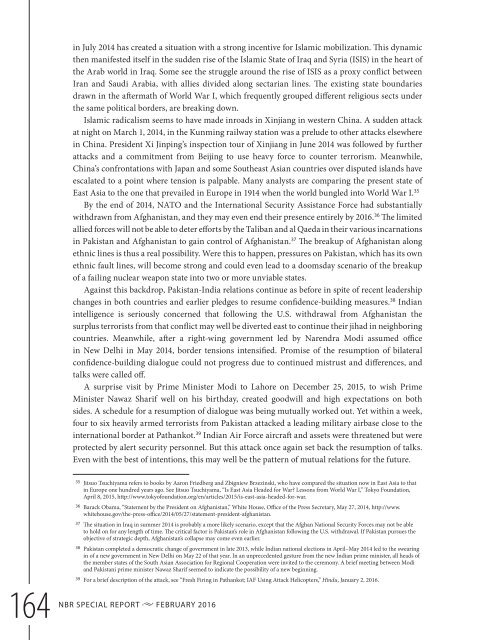pakistan’s
SR55_Mapping_Pakistan_February2016
SR55_Mapping_Pakistan_February2016
You also want an ePaper? Increase the reach of your titles
YUMPU automatically turns print PDFs into web optimized ePapers that Google loves.
in July 2014 has created a situation with a strong incentive for Islamic mobilization. This dynamic<br />
then manifested itself in the sudden rise of the Islamic State of Iraq and Syria (ISIS) in the heart of<br />
the Arab world in Iraq. Some see the struggle around the rise of ISIS as a proxy conflict between<br />
Iran and Saudi Arabia, with allies divided along sectarian lines. The existing state boundaries<br />
drawn in the atermath of World War I, which frequently grouped different religious sects under<br />
the same political borders, are breaking down.<br />
Islamic radicalism seems to have made inroads in Xinjiang in western China. A sudden attack<br />
at night on March 1, 2014, in the Kunming railway station was a prelude to other attacks elsewhere<br />
in China. President Xi Jinping’s inspection tour of Xinjiang in June 2014 was followed by further<br />
attacks and a commitment from Beijing to use heavy force to counter terrorism. Meanwhile,<br />
China’s confrontations with Japan and some Southeast Asian countries over disputed islands have<br />
escalated to a point where tension is palpable. Many analysts are comparing the present state of<br />
East Asia to the one that prevailed in Europe in 1914 when the world bungled into World War I. 35<br />
By the end of 2014, NATO and the International Security Assistance Force had substantially<br />
withdrawn from Afghanistan, and they may even end their presence entirely by 2016. 36 The limited<br />
allied forces will not be able to deter efforts by the Taliban and al Qaeda in their various incarnations<br />
in Pakistan and Afghanistan to gain control of Afghanistan. 37 The breakup of Afghanistan along<br />
ethnic lines is thus a real possibility. Were this to happen, pressures on Pakistan, which has its own<br />
ethnic fault lines, will become strong and could even lead to a doomsday scenario of the breakup<br />
of a failing nuclear weapon state into two or more unviable states.<br />
Against this backdrop, Pakistan-India relations continue as before in spite of recent leadership<br />
changes in both countries and earlier pledges to resume confidence-building measures. 38 Indian<br />
intelligence is seriously concerned that following the U.S. withdrawal from Afghanistan the<br />
surplus terrorists from that conflict may well be diverted east to continue their jihad in neighboring<br />
countries. Meanwhile, ater a right-wing government led by Narendra Modi assumed office<br />
in New Delhi in May 2014, border tensions intensified. Promise of the resumption of bilateral<br />
confidence-building dialogue could not progress due to continued mistrust and differences, and<br />
talks were called off.<br />
A surprise visit by Prime Minister Modi to Lahore on December 25, 2015, to wish Prime<br />
Minister Nawaz Sharif well on his birthday, created goodwill and high expectations on both<br />
sides. A schedule for a resumption of dialogue was being mutually worked out. Yet within a week,<br />
four to six heavily armed terrorists from Pakistan attacked a leading military airbase close to the<br />
international border at Pathankot. 39 Indian Air Force aircrat and assets were threatened but were<br />
protected by alert security personnel. But this attack once again set back the resumption of talks.<br />
Even with the best of intentions, this may well be the pattern of mutual relations for the future.<br />
164<br />
NBR<br />
35 Jitsuo Tsuchiyama refers to books by Aaron Friedberg and Zbigniew Brzezinski, who have compared the situation now in East Asia to that<br />
in Europe one hundred years ago. See Jitsuo Tsuchiyama, “Is East Asia Headed for War? Lessons from World War I,” Tokyo Foundation,<br />
April 8, 2015, http://www.tokyofoundation.org/en/articles/2015/is-east-asia-headed-for-war.<br />
36 Barack Obama, “Statement by the President on Afghanistan,” White House, Office of the Press Secretary, May 27, 2014, http://www.<br />
whitehouse.gov/the-press-office/2014/05/27/statement-president-afghanistan.<br />
37 The situation in Iraq in summer 2014 is probably a more likely scenario, except that the Afghan National Security Forces may not be able<br />
to hold on for any length of time. The critical factor is Pakistan’s role in Afghanistan following the U.S. withdrawal. If Pakistan pursues the<br />
objective of strategic depth, Afghanistan’s collapse may come even earlier.<br />
38 Pakistan completed a democratic change of government in late 2013, while Indian national elections in April–May 2014 led to the swearing<br />
in of a new government in New Delhi on May 22 of that year. In an unprecedented gesture from the new Indian prime minister, all heads of<br />
the member states of the South Asian Association for Regional Cooperation were invited to the ceremony. A brief meeting between Modi<br />
and Pakistani prime minister Nawaz Sharif seemed to indicate the possibility of a new beginning.<br />
39 For a brief description of the attack, see “Fresh Firing in Pathankot; IAF Using Attack Helicopters,” Hindu, January 2, 2016.<br />
SPECIAL REPORT u FEBRUARY 2016



